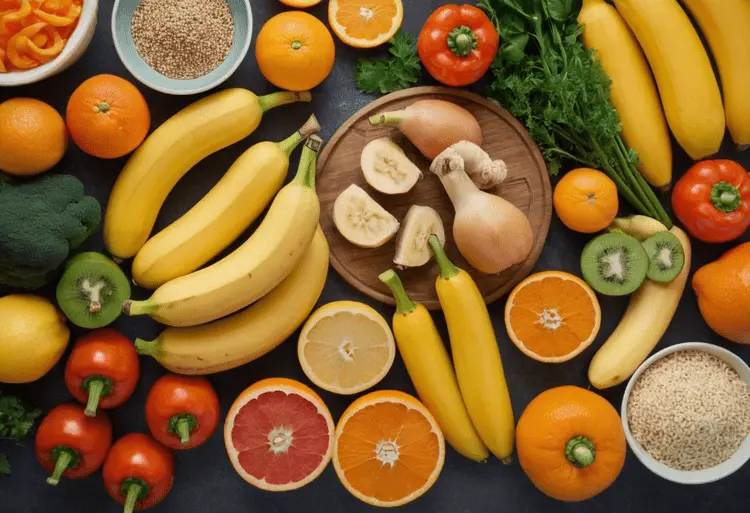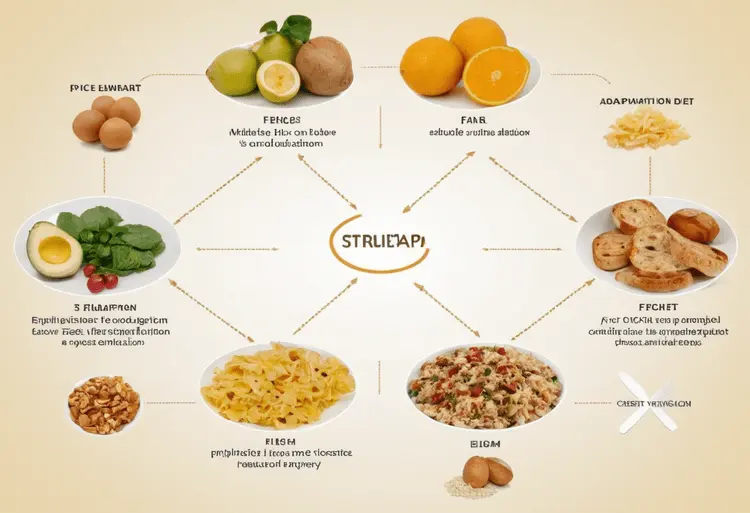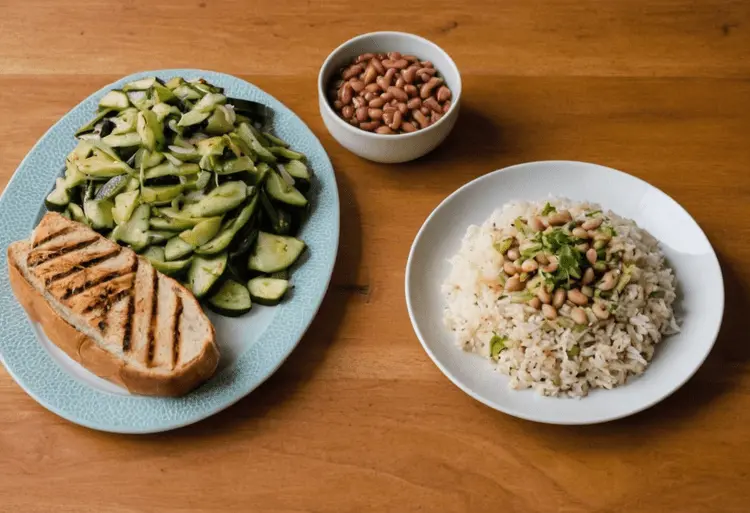The low FODMAP diet sounds promising for IBS relief, but the conflicting information leaves you overwhelmed. Bloating, cramps, and the constant struggle to find safe foods wear you down. You crave clarity amidst the chaos.
IBS diet, FODMAP elimination diet – the terminology adds to the confusion. Can a complex-sounding diet truly simplify your life and bring lasting gut health?
This ultimate low FODMAP diet guide is the solution. It cuts through the clutter, giving you the actionable plan you need. Discover how FODMAPs work, navigate the diet confidently, and finally say goodbye to IBS symptoms.
The Low FODMAP Diet – Your Quickstart Guide
- Learn FODMAP basics
- Follow the 3 phases
- Eliminate high FODMAP foods
- Reintroduce foods slowly
- Discover your tolerance levels
- Create your custom plan
Table of contents
Introduction

Does your stomach constantly feel off? Bloating, gas, unpredictable bowel movements – it’s exhausting! You might wonder if there’s a way to find relief without endless doctor visits and medications. Is there a solution?
The answer could be the low FODMAP diet. What are FODMAPs, you ask? They’re certain types of carbohydrates that your gut might struggle to digest. Think bloating, pain, and all those uncomfortable digestive issues.
But here’s the good news: the low FODMAP diet could turn things around. Imagine feeling more in control, identifying your trigger foods, and enjoying meals without fear. Are you ready to learn how?
This isn’t just another diet fad. It’s a guided approach backed by science, and it has the potential to transform your relationship with food. Think of us as your roadmap to understanding the low FODMAP diet and navigating those tricky food choices.
Here’s what you’ll learn in this guide:
- Firstly, The nitty-gritty on FODMAPs: What they are and why they can wreak havoc on your gut.
- Secondly, A step-by-step breakdown: How the low FODMAP diet works and ways to make it work for you.
- Thirdly, Strategies for long-term success: It’s not just about restriction; it’s about enjoying a wider variety of foods safely.
- Lastly, Tried-and-tested recipes: Because deliciousness matters, even on a low FODMAP plan. Check out FODMAP Everyday for mouthwatering ideas!
Sound exciting? We’re thrilled to have you along for the journey! Feel free to share your experiences in the comments or tag us on social media. Let’s tackle this gut puzzle together!
The Science of Low FODMAP Diet
What are FODMAPs?
Ever felt bloated, gassy, or just plain uncomfortable after a meal? If you have IBS, those pesky culprits might be FODMAPs. But what the heck are they?
FODMAPs are short-chain carbohydrates that your small intestine struggles to absorb. Instead, they hang out in your gut, fermenting and causing all sorts of trouble.
The Different Types of FODMAPs
Think of FODMAPs as a gang of troublemakers. Let’s meet the crew:
- Oligosaccharides: Fructans and GOS. These are found in foods like wheat, onions, garlic, and legumes.
- Disaccharides: Lactose. The main sugar in milk and some dairy products.
- Monosaccharides: Fructose. Found in certain fruits like honey, mangoes, and apples
- Polyols: Sorbitol and mannitol. Hiding in stone fruits and some artificial sweeteners.
So, is a low FODMAP diet the answer to your digestive woes? Maybe! But first, let’s dig deeper into how these little sugars cause such big problems.
Specifically, those poorly digested FODMAPs draw water into your gut, which leads to bloating and pain. Plus, bacteria feast on them, causing gas and changes in bowel habits. Ugh, right?
Now that you’ve mastered the low FODMAP diet, it’s time to fill your kitchen with flavorful, gut-friendly creations! Discover mouthwatering recipes that will nourish your body and taste buds in my Ultimate Guide to Gut Health Recipes.
Starting and Sticking with the Low FODMAP Diet
It’s Not Forever – The 3 Phases
Changing your diet can be overwhelming, especially when you’re dealing with uncomfortable gut issues. Is the low FODMAP diet going to be another fad you try for a few weeks and forget?
Absolutely not! Let’s break down the three distinct phases to help you see the light at the end of the tunnel.
- Phase 1: Restriction Think of this as a reset for your gut. You’ll temporarily eliminate higher FODMAP foods from your diet. Don’t worry, this phase is typically short – just 2-6 weeks.
- Phase 2: Reintroduction This is where you become a gut detective! You’ll systematically reintroduce FODMAP foods, one group at a time, and track your symptoms. This is how you find your personal FODMAP triggers.
- Phase 3: Adaptation This is about creating a sustainable, long-term eating plan. Using your detective notes from Phase 2, you’ll personalize your low FODMAP diet to feel your best.
Low FODMAP Diet Before You Begin
Ready to jump in? Hold on! It’s crucial to chat with your doctor or a registered dietitian before starting the low FODMAP diet. They can help rule out other conditions and guide you through the process.
Remember, the goal of the low FODMAP diet isn’t about deprivation, it’s about finding YOUR path to gut health!
Step-by-Step Guide to Phase 1
Phase 1 is all about swaps. You need a comprehensive list of what foods to avoid and what to enjoy instead.Check out resources like FODMAP Everyday for delicious, gut-friendly recipes and the Official Monash University low FODMAP app: to be sure about ingredients.
Here’s a little taste of what you’ll be swapping out and in:
- Out: Onions, garlic, wheat
- In: Green onions (tops only), chives, oats, gluten-free breads
What to Expect During Low FODMAP Diet Elimination Phase

You might start feeling relief quickly, but for some folks, it takes a bit longer. Be patient with your body! Feeling a little tired or experiencing changes in bowel movements? This can be normal in the first few weeks. Hang in there, it gets better!
Let me know – have you tried a low FODMAP diet before? What was your experience like? Share below or tag me on social media!
Reintroducing FODMAPs – Your Custom Plan
Ready to get some favorite foods back in your life? Let’s talk reintroduction! This phase of the low FODMAP diet is absolutely crucial. Why is it so important? Because it lets you figure out your unique gut sensitivities – not just a generic list of FODMAPs.
Why Reintroduction is Essential
Think of the elimination phase as a reset. Now, the reintroduction phase is about building a sustainable, enjoyable way of eating – minimizing long-term restriction and fear around food.
You’ll learn what FODMAPs truly bother your system and in what amounts. This is where the low FODMAP diet becomes a true lifestyle tool.
Low FODMAP Diet Challenges – How They Work
Here’s where it gets a bit methodical, but trust me, it’s worth it! FODMAP challenges involve testing one FODMAP group at a time. You’ll eat a food high in that specific FODMAP for a few days and carefully track your symptoms.
- A great resource for finding low FODMAP recipes to use for your challenges is FODMAP Everyday. Their recipes are simple and delicious, making this phase less intimidating.
Got a notebook handy? Good! Symptom tracking is key. Any gas, bloating, pain – write it down, along with the food and the amount you ate.
Understanding FODMAP Tolerance
Is there a magic number of FODMAPs you can tolerate? Sadly, no. Everyone’s gut is different! Some people might sail through lactose reintroduction, but struggle with fructose. Others might find their gut can handle a bit of garlic with no problem.
Think of your tolerance in terms of a “safe zone”. As you complete challenges, you’ll identify FODMAPs that are total no-gos and those you can enjoy in smaller portions.
Pro tip: Pay attention to portion size! A small serving of a certain FODMAP food might be totally fine, while a larger one could set off your IBS symptoms.
Mastering Long-Term Success
Building Your Personalized Low FODMAP Diet
The reintroduction phase is over. You’ve got personalized data – what now? Time to turn findings into a sustainable, enjoyable low FODMAP lifestyle!
- Focus on what you CAN eat. Your “safe” list is likely longer than you think. Use it to create exciting meals and snacks.
- Experiment with flavors and textures. Low FODMAP doesn’t equal boring.
- Find balance. It’s okay to occasionally incorporate small amounts of higher-FODMAP foods if you tolerate them.
Mindset Matters
Think of this as progress, not dietary perfection. Will you have occasional symptom flares? Probably, but you’ll learn what triggers them and how to adapt.
- Ditch the food guilt. Occasional indulgences are okay, especially when managed strategically.
- Focus on the big picture. Are your overall symptoms reduced? Is your quality of life better? A long-term view keeps slip-ups in perspective.
Low FODMAP Recipes and Resources
Sticking to your low FODMAP diet shouldn’t feel overwhelming. Arm yourself with reliable resources, and don’t hesitate to adapt:
- Recipe Websites: There are tons! Your taste buds will thank you.
- Accurate Information: Sites like the [reliable IBS information from IFFGD] (International Foundation for Gastrointestinal Disorders website) offer trusted guidance.
- Support Systems: Online communities and even certain dieticians specialize in the low FODMAP diet.
Extra Tips:
- Pre-portion snacks for on-the-go ease.
- Plan ahead when eating out to avoid stress. Restaurants are more adaptable than you think.
- Batch cook low FODMAP staples to simplify mealtimes.
Conclusion

So, have you found relief on the low FODMAP diet? Is there something you’re still struggling with? Let’s keep the conversation going – share your experiences below!
Change can be tough, but remember, you’re not alone. Thousands of people manage their IBS and bloating with the low FODMAP approach. For even more recipes and a sense of community, head over to FODMAP Everyday – they have amazing resources for making this diet delicious.
And seriously, knowledge is power when it comes to managing your gut health! If getting precise about which FODMAPs cause you problems is appealing, the official Monash University low FODMAP app is your best bet.
This journey might have twists and turns. There will be great days and maybe a few frustrating ones too. But consider this:
- You’re taking control of your health.
- You’re learning to listen to your body.
- You’re building a sustainable way to enjoy food again.
That’s progress worth celebrating! Let me know how things are going – you can even tag me on social media!
The low FODMAP diet is a fantastic start, but did you know there are even more amazing foods that nourish your gut? Click here to unlock the full potential of a happy, healthy digestive system
Your Low FODMAP Questions Answered
Let’s clear up some of that low FODMAP diet confusion, shall we? Got a burning question? I’m here to help!
Lots of options! Think meat, fish, certain fruits and veggies, rice, oats, and lactose-free dairy.
Fermentable Oligosaccharides, Disaccharides, Monosaccharides, And Polyols.
Regular coffee is usually okay in small amounts. Watch out for caffeine sensitivity, though!
“Free foods” are less likely to cause trouble, but portion sizes still matter. Listen to your body!
Fermentable Oligosaccharides, Disaccharides, Monosaccharides, and Polyols. (It’s a mouthful, I know!)
Regular coffee is generally considered low FODMAP in moderation. However, some people are sensitive to caffeine itself, which can trigger IBS symptoms.
“Free foods” are unlikely to trigger symptoms for most people, BUT portion sizes still matter. Your tolerance will be individual!